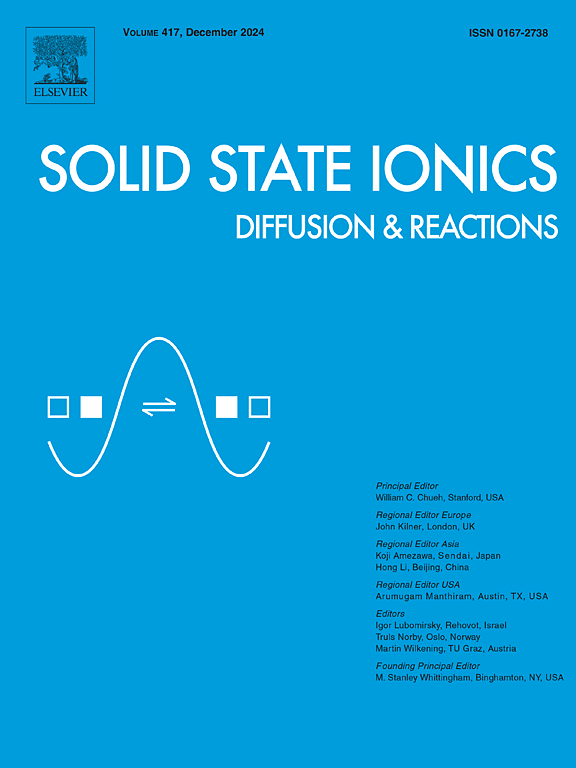Preparation and electrical conductivity of core-shell structured Ce0.8Sm0.2O1.90-δ@xBaCe0.8Sm0.2O2.95-δ (x = 0, 0.5, 1, 1.5) ceramics
IF 3
4区 材料科学
Q3 CHEMISTRY, PHYSICAL
引用次数: 0
Abstract
Core-shell structured powders of Ce0.8Sm0.2O1.90-δ(SDC)@xBaCe0.8Sm0.2O2.95-δ(BCS) (x = 0, 0.5, 1, 1.5) were synthesized by a two-step co-precipitation method and then sintered to prepare the corresponding SDC@xBCS (x = 0, 0.5, 1, 1.5) ceramics. The XRD detection combined with SEM and TEM analysis confirms that the powders and ceramics are only composed of SDC and BCS phases, and no other phases are detected. The average diameter of the spherical core-shell structured SDC@xBCS powders is in 20–60 nm. A thin layer of BCS is coated on the surface of SDC in the synthesized SDC@BCS nanopowders, and a core-shell structure forms in the SDC@BCS composite ceramics. With the increase of the ratio of BCS:SDC from 1 to 1.5, the sample is more difficult to be densified. For x = 1, the sample of SDC@BCS achieves the highest electrical conductivity in four samples (x = 0, 0.5, 1, 1.5). At the test temperature of 600 °C, the electrical conductivity of the core-shell structured SDC@BCS ceramic (1:1) is higher than that of the common uniformly-mixed SDC-BCS samples, i.e., 1.545 × 10−2 S/cm and 0.685 × 10−2 S/cm in air and 10 %H2–90 %N2 atmosphere, respectively. At the same time, the specific grain boundary electrical conductivity of the core-shell structured SDC@BCS ceramics is also higher than that of uniformly mixed SDC-BCS composite ceramics. The construction of a core-shell structure can contribute to improving the electrical conductivity of the SDC-BCS composite ceramics.
核壳结构ce0.8 sm0.2 2o1.90 -δ@ xbace0.8 sm0.2 2o2.95 -δ (x = 0,0.5, 1,1.5)陶瓷的制备及电导率
采用两步共沉淀法合成了ce0.8 sm0.2 2o1.90 -δ(SDC)@ xbace0.8 sm0.2 2o2.95 -δ(BCS) (x = 0,0.5, 1,1.5)的核壳结构粉末,并进行了烧结制备了相应的SDC@xBCS (x = 0,0.5, 1,1.5)陶瓷。XRD检测结合SEM和TEM分析证实粉末和陶瓷仅由SDC和BCS相组成,未检测到其他相。球形核壳结构SDC@xBCS粉末的平均直径在20 ~ 60 nm之间。在合成的SDC@BCS纳米粉体的SDC表面涂覆薄层BCS,在SDC@BCS复合陶瓷中形成核壳结构。随着BCS:SDC的比值从1增加到1.5,样品的致密化难度增大。当x = 1时,SDC@BCS样品在4个样品(x = 0,0.5, 1,1.5)中电导率最高。在600℃的测试温度下,核壳结构SDC@BCS陶瓷(1:1)的电导率高于普通均匀混合的SDC-BCS样品,在空气和10% h2 - 90% N2气氛中的电导率分别为1.545 × 10−2 S/cm和0.685 × 10−2 S/cm。同时,核壳结构SDC@BCS陶瓷的比晶界电导率也高于均匀混合的SDC-BCS复合陶瓷。核壳结构的构建有助于提高SDC-BCS复合陶瓷的导电性。
本文章由计算机程序翻译,如有差异,请以英文原文为准。
求助全文
约1分钟内获得全文
求助全文
来源期刊

Solid State Ionics
物理-物理:凝聚态物理
CiteScore
6.10
自引率
3.10%
发文量
152
审稿时长
58 days
期刊介绍:
This interdisciplinary journal is devoted to the physics, chemistry and materials science of diffusion, mass transport, and reactivity of solids. The major part of each issue is devoted to articles on:
(i) physics and chemistry of defects in solids;
(ii) reactions in and on solids, e.g. intercalation, corrosion, oxidation, sintering;
(iii) ion transport measurements, mechanisms and theory;
(iv) solid state electrochemistry;
(v) ionically-electronically mixed conducting solids.
Related technological applications are also included, provided their characteristics are interpreted in terms of the basic solid state properties.
Review papers and relevant symposium proceedings are welcome.
 求助内容:
求助内容: 应助结果提醒方式:
应助结果提醒方式:


